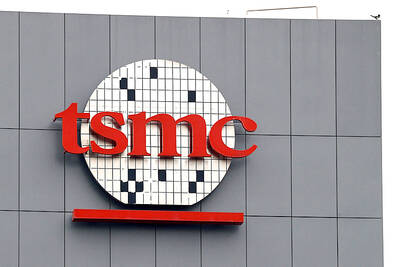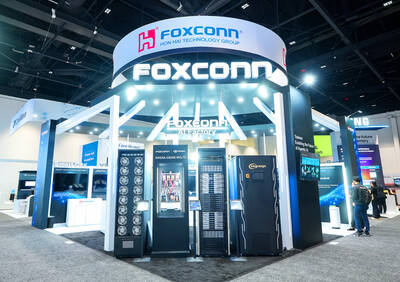Falling TV panel prices and the strengthening New Taiwan dollar have hit major Taiwanese flat-panel makers, resulting in lower sales last month and the last quarter, according to the latest company figures released last week.
While signs of a pick up in panel demand started to emerge last month, AU Optronics Corp’s (友達光電) consolidated sales last month dropped 16.95 percent from November, Chunghwa Picture Tubes Ltd (中華映管) saw its sales fall 8.77 percent and those of HannStar Display Corp (瀚宇彩晶) were 2.29 percent lower than a month earlier.
“The decrease in the December revenue was associated with the lower-than-expected TV panel prices, customer inventory control by the end of the year and the currency influence of NT dollar appreciation,” AU Optronics, the nation’s second-largest LCD panel maker, said in a statement on Friday.

PHOTO: CHEN MEI-YING, TAIPEI TIMES
Speaking to reporters at a tree-planting ceremony on Saturday at the company’s Houli plant in Greater Taichung, AU Optronics chairman Lee Kun-yao (李焜耀) said he had seen signs of “pull-in orders” to meet demand for the Lunar New Year, but was less certain about the price outlook, local cable TV network UBN quoted him as saying.
Last week, Citigroup analyst Jonathan Rhee said in a report that IT panel customers might start restocking given limited room for further price drops, but TV panel prices could continue to fall in the short term, although at a slower rate.
“Going forward, we expect recovery in demand ahead of Chinese New Year and rebounding IT panel price shifting capacity away from TV to IT panel production to be positive factors in panel price -stabilization,” Rhee said on Thursday.
Taiwanese panel makers also face a critical test in their ability to hedge against foreign exchange losses this year, as the New Taiwan dollar closed at NT$29.80 against the US dollar on Friday, a level not seen since Oct. 20, 1997.
Lee said on Saturday a fast appreciation in the value of the New Taiwan dollar posed a threat to Taiwan’s panel makers, especially in the face of strong competition from their South Korean rivals.
Moreover, a sharp depreciation in the South Korean won against the US dollar because of the standoff on the Korea Peninsula has led to an appreciation in the New Taiwan dollar against the South Korean currency, putting more pressure on Taiwanese firms, the Chinese-language Liberty Times (the Taipei Times’ sister newspaper) quoted him as saying.
The local currency has risen 4.88 percent against the greenback since October and has appreciated 3.65 percent against the won over the same period, the central bank’s data showed.
Last month, AU Optronics posted NT$30.62 billion (US$1.03 billion) in sales, its lowest since June 2008 when it reported NT$30.4 billion in sales. The figure was not only 16.95 percent lower than the previous month, but also 16.87 percent less than a year earlier, the company’s data showed.
In the October to December period, the Hsinchu-based company saw its revenue fall 17.51 percent to NT$102.62 billion from the previous three months, 10.66 percent less than a year ago. For the whole of last year, however, revenue expanded 30.01 percent to NT$467.17 billion from 2009.
AU Optronics did not provide a sales forecast for this quarter or this year, but it expects demand to recover gradually.
“As sell-through picked up during the holiday period and the customer inventory adjustments have gradually come to an end, we expect that panel demand will progressively recover,” the company said in the statement.
Also on Friday, HannStar Display said its sales dropped 2.24 percent to NT$3.4 billion month-on-month and fell 26.94 percent year-on-year. In the last three months, revenue totaled NT$10.21 billion, down 20.34 percent from the previous three months and 27.39 percent lower than a year ago, the company’s data showed.
On Thursday, the nation’s No. 3 panel maker Chunghwa Picture posted NT$5.25 billion in sales last month, down 8.77 percent month-on-month and 13.38 percent year-on-year. On a quarterly basis, fourth-quarter revenue of NT$16.6 billion was 14.46 percent lower than the third quarter and fell 3.31 percent from a year earlier.
Like AU Optronics, both Chunghwa Picture and Hannstar Display also registered increases in full-year revenue last year. Chunghwa Picture was up 38.83 percent to NT$81.7 billion and Hannstar Display was up 8.36 percent to NT$54.93 billion.
Chimei Innolux Corp (奇美電子) is expected to release its sales figures for last month and the whole of last year later this week.

Anna Bhobho, a 31-year-old housewife from rural Zimbabwe, was once a silent observer in her home, excluded from financial and family decisionmaking in the deeply patriarchal society. Today, she is a driver of change in her village, thanks to an electric tricycle she owns. In many parts of rural sub-Saharan Africa, women have long been excluded from mainstream economic activities such as operating public transportation. However, three-wheelers powered by green energy are reversing that trend, offering financial opportunities and a newfound sense of importance. “My husband now looks up to me to take care of a large chunk of expenses,

SECTOR LEADER: TSMC can increase capacity by as much as 20 percent or more in the advanced node part of the foundry market by 2030, an analyst said Taiwan Semiconductor Manufacturing Co (TSMC, 台積電) is expected to lead its peers in the advanced 2-nanometer process technology, despite competition from Samsung Electronics Co and Intel Corp, TrendForce Corp analyst Joanne Chiao (喬安) said. TSMC’s sophisticated products and its large production scale are expected to allow the company to continue dominating the global 2-nanometer process market this year, Chiao said. The world’s largest contract chipmaker is scheduled to begin mass production of chips made on the 2-nanometer process in its Hsinchu fab in the second half of this year. It would also hold a ceremony on Monday next week to

State-run CPC Corp, Taiwan (CPC, 台灣中油) yesterday signed a letter of intent with Alaska Gasline Development Corp (AGDC), expressing an interest to buy liquefied natural gas (LNG) and invest in the latter’s Alaska LNG project, the Ministry of Economic Affairs said in a statement. Under the agreement, CPC is to participate in the project’s upstream gas investment to secure stable energy resources for Taiwan, the ministry said. The Alaska LNG project is jointly promoted by AGDC and major developer Glenfarne Group LLC, as Alaska plans to export up to 20 million tonnes of LNG annually from 2031. It involves constructing an 1,290km

NEXT GENERATION: The company also showcased automated machines, including a nursing robot called Nurabot, which is to enter service at a Taichung hospital this year Hon Hai Precision Industry Co (鴻海精密) expects server revenue to exceed its iPhone revenue within two years, with the possibility of achieving this goal as early as this year, chairman Young Liu (劉揚偉) said on Tuesday at Nvidia Corp’s annual technology conference in San Jose, California. AI would be the primary focus this year for the company, also known as Foxconn Technology Group (富士康科技集團), as rapidly advancing AI applications are driving up demand for AI servers, Liu said. The production and shipment of Nvidia’s GB200 chips and the anticipated launch of GB300 chips in the second half of the year would propel